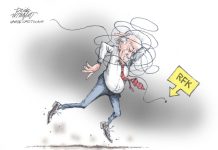The Chicago Tribune
Running up debt, like partying hard on Saturday night, can be great fun. But a late night with lots of cocktails makes for a miserable Sunday morning. Over the past few years, though, the United States government has been able to binge freely without suffering hangovers. That is about to change, with a vengeance.
Since 2007, when the Great Recession hit, the federal budget has been even more out of balance than it was in the preceding years. In the years since, the national debt — that is, the amount taxpayers owe — more than doubled, to nearly $20 trillion.
After soaring in 2008 and 2009, the annual budget deficit declined, but never fell as low as it was in 2007. And it’s not falling anymore: In the fiscal year that ended Sept. 30, it was $538 billion, up by $100 billion over 2015. Don’t expect a turnaround. The aging of the baby boomer generation will push up costs for Social Security and Medicare for years to come.
Fiscal excess is not a free luxury, of course. Debt has to be repaid, with interest. But the nation’s taxpayers have gotten off pretty easy. Interest rates have been blissfully low since the economy crashed, largely due to the Federal Reserve’s policies. In 2015, the government’s interest expense amounted to just 1.24 percent of gross domestic product — the smallest share since 1973.
But like a teaser rate on a credit card, the rates the Treasury has to pay to finance the debt won’t stay low for long. As the economy continues to grow and the Federal Reserve moves to raise rates, interest will get much more expensive. The hangover will finally hit.
“The government’s net interest costs are projected to more than double as a share of the economy over the next decade — from 1.4 percent of GDP in 2016 to 3.0 percent by 2026,” the Congressional Budget Office reported in August. “By 2046, if current laws governing taxes and spending generally did not change, those costs would reach 5.8 percent of GDP — increasing from 6 percent of federal spending to 21 percent over the next 30 years.”
Interest costs — arguably our least productive spending — promise to become the fastest-growing item in the budget. That’s if deficits remain on the trajectory established by existing policies. In reality, though, they are likely to get even bigger, as a result of Donald Trump’s expensive agenda.
The bipartisan Committee for a Responsible Federal Budget estimates that the spending increases and tax cuts he wants would fatten total deficits by $5.2 trillion by 2026. “That would lead directly to an $800 billion increase in interest costs over a decade, including over $150 billion in (fiscal year) 2026 alone,” it predicts.
That’s not all. Growing budget deficits tend to push up interest rates. That raises the cost of financing the debt, which increases federal spending, which expands the budget deficit even more — and so on, in a vicious circle. The CRFB warns that federal interest costs “could quadruple or even quintuple” if Trump’s plans come to fruition.
All this is merely the latest reminder that the federal government can’t keep the fiscal party going forever. Sooner or later, the load on taxpayers will become too heavy and the squeeze on other priorities will grow too painful.
So congressional Republicans — and Democrats — have a duty to get serious and finally take the sensible steps needed to bring down deficits and debt. Otherwise, the nation can expect a pounding headache that never stops.
This editorial appeared in The Chicago Tribune. Send comments to [email protected].




